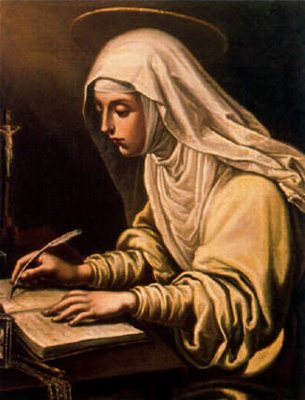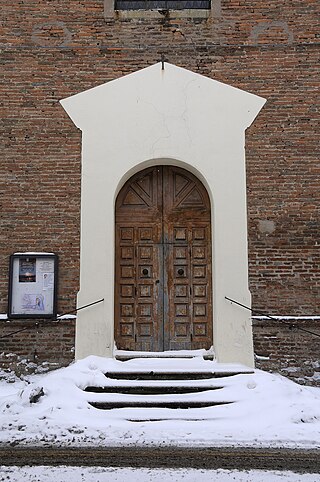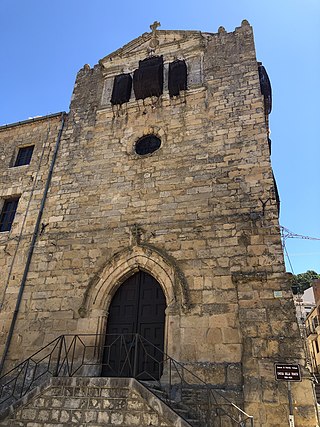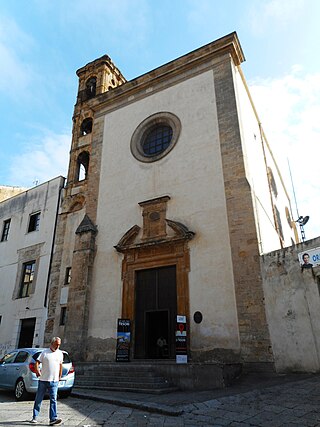
In Eastern Christianity, an iconostasis is a wall of icons and religious paintings, separating the nave from the sanctuary in a church. Iconostasis also refers to a portable icon stand that can be placed anywhere within a church. The iconostasis evolved from the Byzantine templon, a process complete by the 15th century.

Rita of Cascia, born Margherita Lotti, was an Italian widow and Augustinian nun venerated as a saint in the Roman Catholic Church.

Gemma Umberta Maria Galgani, also known as Gemma of Lucca, was an Italian mystic, venerated as a saint in the Catholic Church since 1940. She has been called the "daughter of the Passion" because of her profound imitation of the Passion of Christ. She is especially venerated in the Congregation of the Passion of Jesus (Passionists).

Sant'Anna dei Lombardi,, and also known as Santa Maria di Monte Oliveto, is an ancient church and convent located in piazza Monteoliveto in central Naples, Italy. Across Monteoliveto street from the Fountain in the square is the Renaissance palace of Orsini di Gravina.

San Maurizio al Monastero Maggiore is a church in Milan, Northern Italy. It was originally attached to the most important female convent of the Benedictines in the city, Monastero Maggiore, which is now in use as the Civic Archaeological Museum. The church today is used every Sunday from October to June to celebrate in the Byzantine Rite, in Greek according to the Italo-Albanian tradition. It is also used as concert hall.

Saint Augustine's, Kilburn, is a Church of England church in the area of Kilburn, in North London, United Kingdom. Because of its large size and ornate architecture, it is sometimes affectionately referred to as "the Cathedral of North London", although the church is not a cathedral in any official sense.
The Passionist nuns are an order of nuns in the Roman Catholic Church. It was the second Passionist order to be established, founded by St. Paul of the Cross and a nun known as Mother Mary Crucified in 1771.

The Real Monasterio de la Encarnación is a convent of the order of Recollet Augustines located in Madrid, Spain. The institution mainly interned women from noble families, and was founded by the Queen Margaret of Austria, wife of Philip III, and thus was well endowed with wealth. Although it belongs to an enclosed religious order, the building is open to the public under the administration of the Patrimonio Nacional.

Catherine de' Ricci, was an Italian Dominican Tertiary sister. She is believed to have had miraculous visions and corporeal encounters with Jesus, both with the infant Jesus and with the adult Jesus. She is said to have spontaneously bled with the wounds of the crucified Christ. She is venerated for her mystic visions and is honored as a saint by the Catholic Church.

Maribo Cathedral is a Gothic cathedral church in Maribo on the island of Lolland in the southeast of Denmark. It was originally part of Maribo Abbey which was founded in the early 15th century. The chancel, the oldest section of the cathedral, probably dates from 1416. The plan of the church is unusual in that the chancel is at the west end of the building rather than the east as a result of the design instructions left by Saint Bridget.
San Marino is a small landlocked country with an area of about 61.2 km2 (23.6 sq mi) on a rocky promontory at an elevation of 657 meters (2,156 ft) in central Italy. It is the third smallest country in Europe after Vatican City and Monaco. It was founded as a Republic in 600 AD and recognized by the Papacy in 1631, and became a member of the United Nations in 1992. As of 2009, it had a population of 31,500. The ethnic composition is about 84.95% Sammarinese, 14.6% Italians and others. The country does not provide exact statistics of the religious affiliations of its people. However, it is inferred that at least 95% of the people are Catholics, as in Italy, but with a historical Jewish and Protestant minority. There are other small groups, including Jehovah's Witnesses, Waldensians. San Marino's schools are all public and financial support is provided by the State; there are no private religious schools.

Santa Maria Regina Coeli is a Roman Catholic church in central Naples, Italy.

The Cult of the Lord Holy Christ of the Miracles, popularly known as Senhor Santo Cristo or Santo Cristo dos Milagres is a religious veneration associated with an image of Jesus Christ, depicted in the events of the New Testament. The wooden image of Christ, by unknown artist, in a Renaissance-style representation of the Ecce Homo, represents the episode of Jesus of Nazareth's life when the martyred religious figure was presented to the crowd following his whipping, and includes a crown of thorns, uncovered torso and bruised/beaten body. Narrated in the New Testament, the artist represented in grande artistic style the contrast between violence on the body and the serenity of the expression, emphasized by the gaze from the image.

The Minor Basilica of Santi Vicenzo e Caterina de' Ricci is a Catholic church, built in the 16th to 18th centuries, and located in the town of Prato, in Tuscany, Italy. Adjacent to the church is a 16th-century monastery.
Sant'Anna is a Gothic style, Roman Catholic parish church, located in Piacenza, Region of Emilia Romagna, Italy.

Santa Chiara is a Baroque style, Roman Catholic church or chapel constructed as part of the former Convent of the Clarissan nuns in Pieve di Cento, Region of Emilia-Romagna, Italy.

San Niccolò al Carmine, also called Santa Maria del Carmine is a Renaissance style, Roman Catholic church and monastery located in Pian dei Mantellini #30, near the corner of Via della Diana in the Terzo de Citta of Siena, region of Tuscany, Italy. The church now serves as the Oratory for the Contrada of Pantera. Across the street from the belltower is the Palazzo Celsi Pollini. North along Pian dei Mantellini, toward the Arco delle Due Porte, and on the same side of the street are a number of palaces built around what was once the Monastery of the Derelict Women: in order they are the Neoclassical Palazzo Incontri, the Palazzo Ravissa and the Palazzo Segardi.

The Church of the Visitation is a 17th-century Roman Catholic church, attached to a monastery, located on Via XX Settembre #23 in central Turin, region of Piedmont, Italy.

Santissima Trinità is a Roman Catholic church building, attached to an cloistered Dominican abbey for nuns, is located in the district of Carminello, just outside the town center of Petralia Sottana, province of Palermo, Sicily.

Santa Chiara all'Albergaria refers to a church and former monastery located in piazza Santa Chiara, in the quarter of Albergaria in the city of Palermo, region of Sicily, Italy. The church is located near the busy outdoor Ballarò marketplace.


















